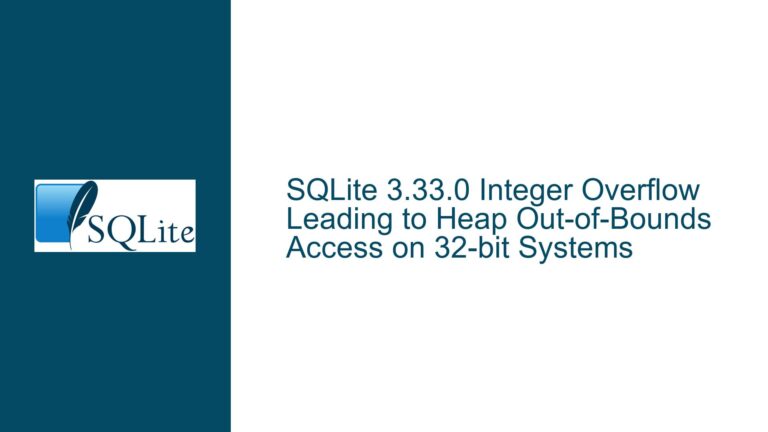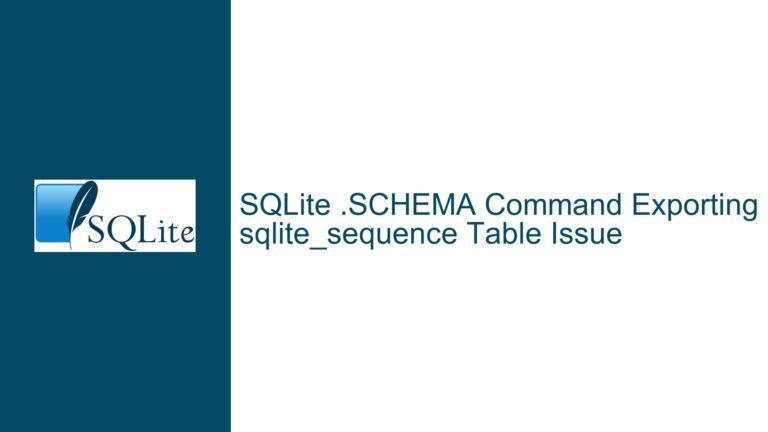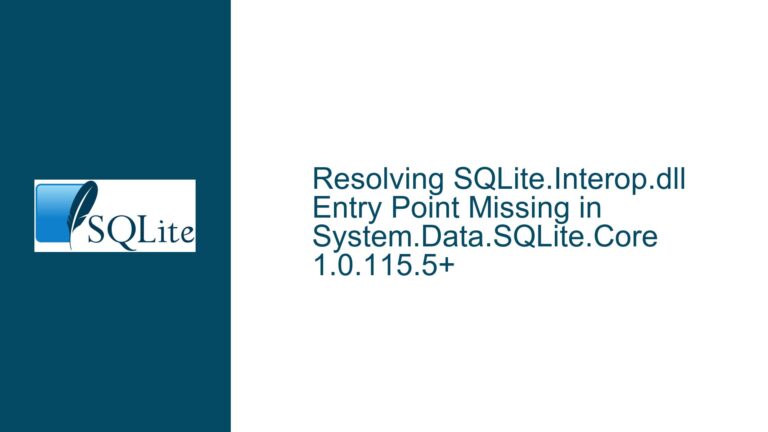System.Data.SQLite: Incorrect UNIQUE Flag in GetSchemaTable() for Columns Allowing NULL
Issue Overview: Misidentification of UNIQUE Columns in GetSchemaTable()
The core issue revolves around the behavior of the GetSchemaTable() method in the System.Data.SQLite library, specifically when determining the uniqueness of columns in a SQLite database. The problem manifests when a column is defined as UNIQUE but also allows NULL values. In such cases, the GetSchemaTable() method fails to correctly flag the column as unique, even though the column’s definition in the database schema explicitly enforces uniqueness.
The issue is particularly evident when examining the schema information for a table with the following definition:
CREATE TABLE mytable (
id TEXT PRIMARY KEY,
name TEXT UNIQUE
);
When querying this table with a SELECT statement and subsequently calling GetSchemaTable() on the resulting SQLiteDataReader, the id column is correctly identified as both a key and unique (isUnique and isKey flags are set). However, the name column, despite being defined as UNIQUE, does not have the isUnique flag set. This behavior persists even when a UNIQUE index is explicitly created on the name column.
The root of the problem appears to lie in the implementation of the GetSchemaTable() method, specifically in the logic used to determine whether a column should be flagged as unique. The current implementation includes a conditional check that considers whether the column allows NULL values (allowDbNull). This check seems to incorrectly influence the determination of uniqueness, leading to the observed behavior.
Possible Causes: Heuristics and NULL Handling in Schema Determination
The issue stems from the heuristics employed by the GetSchemaTable() method to infer schema information from the result set. These heuristics are designed to approximate the schema based on the available metadata, but they are not always precise. In this case, the heuristic logic incorrectly ties the uniqueness of a column to its ability to accept NULL values.
The problematic code block in SQLiteDataReader.cs is as follows:
if (parentToColumns.Count == 1 && tblIndexColumns.Rows.Count == 1 && allowDbNull == false)
row[SchemaTableColumn.IsUnique] = rowIndexes["UNIQUE"];
This condition checks three things:
- Whether the column has a single parent (
parentToColumns.Count == 1). - Whether there is exactly one row in the index columns table (
tblIndexColumns.Rows.Count == 1). - Whether the column does not allow
NULLvalues (allowDbNull == false).
The third condition is particularly problematic because it implies that a column cannot be considered unique if it allows NULL values. This is incorrect from a database design perspective. In SQLite (and most relational databases), a UNIQUE constraint ensures that all non-NULL values in the column are distinct. NULL values are treated as distinct from each other, meaning multiple NULL values are allowed in a UNIQUE column. Therefore, the ability to accept NULL values should not affect the determination of uniqueness.
The current implementation conflates the concepts of uniqueness and nullability, leading to incorrect schema information being returned by GetSchemaTable(). This misalignment between the actual database schema and the inferred schema can cause issues in applications that rely on accurate schema metadata, such as ORM frameworks or data migration tools.
Troubleshooting Steps, Solutions & Fixes: Addressing the UNIQUE Flag Misidentification
To resolve the issue, the logic in GetSchemaTable() must be updated to correctly identify UNIQUE columns, regardless of their nullability. Below are the steps to troubleshoot, analyze, and fix the problem:
Step 1: Verify the Database Schema
Before diving into the code, it is essential to confirm that the database schema is correctly defined and that the UNIQUE constraint is properly enforced. Execute the following SQL statements to inspect the schema:
PRAGMA table_info(mytable);
PRAGMA index_list(mytable);
The table_info pragma will display the columns in the mytable table, including their data types and constraints. The index_list pragma will show the indexes defined on the table, including any UNIQUE indexes. Ensure that the name column is listed as UNIQUE and that the corresponding index exists.
Step 2: Analyze the GetSchemaTable() Implementation
Examine the GetSchemaTable() method in SQLiteDataReader.cs to understand how the schema information is constructed. Focus on the section where the isUnique flag is set for each column. The current implementation uses the following condition:
if (parentToColumns.Count == 1 && tblIndexColumns.Rows.Count == 1 && allowDbNull == false)
row[SchemaTableColumn.IsUnique] = rowIndexes["UNIQUE"];
This condition must be modified to remove the dependency on allowDbNull. The uniqueness of a column should be determined solely by the presence of a UNIQUE constraint or index, not by its nullability.
Step 3: Modify the Heuristic Logic
Update the heuristic logic to correctly identify UNIQUE columns. The revised condition should look like this:
if (parentToColumns.Count == 1 && tblIndexColumns.Rows.Count == 1)
row[SchemaTableColumn.IsUnique] = rowIndexes["UNIQUE"];
By removing the allowDbNull == false check, the method will correctly flag columns as unique based on their constraints, regardless of whether they allow NULL values.
Step 4: Test the Updated Implementation
After modifying the code, thoroughly test the updated GetSchemaTable() method to ensure it behaves as expected. Create a test table with various combinations of UNIQUE and NULL constraints, and verify that the schema information returned by GetSchemaTable() accurately reflects the table’s structure. For example:
CREATE TABLE test_table (
col1 TEXT PRIMARY KEY,
col2 TEXT UNIQUE,
col3 TEXT UNIQUE NOT NULL
);
Query the table and inspect the schema information for each column. Ensure that col2 and col3 are both flagged as unique, even though col2 allows NULL values.
Step 5: Handle Edge Cases
Consider edge cases where the heuristic logic might still fail. For example, composite UNIQUE constraints (involving multiple columns) or columns that are part of multiple indexes. Update the logic to handle these scenarios appropriately. For composite constraints, ensure that all columns involved in the constraint are correctly identified as part of a unique set.
Step 6: Submit a Patch or Report the Issue
If you are not the maintainer of the System.Data.SQLite library, submit a patch with the proposed changes or report the issue to the maintainers. Provide a detailed explanation of the problem, the proposed fix, and the test cases used to verify the solution. This will help ensure that the issue is addressed in future releases of the library.
Step 7: Implement a Workaround (Temporary Solution)
If an immediate fix is not available, implement a workaround in your application. For example, manually inspect the database schema using SQL queries and override the schema information returned by GetSchemaTable() as needed. While this approach is less efficient, it can serve as a temporary solution until the issue is resolved in the library.
By following these steps, you can address the misidentification of UNIQUE columns in GetSchemaTable() and ensure that your application receives accurate schema information from the System.Data.SQLite library.






